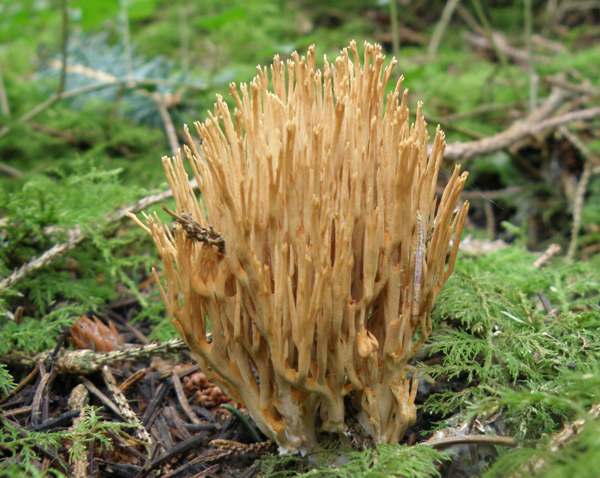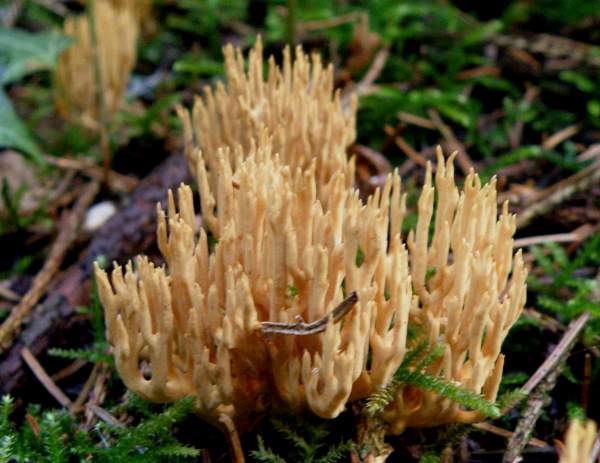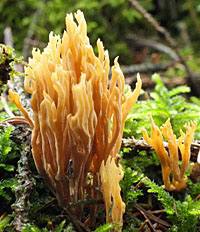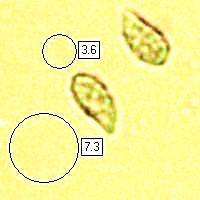Ramaria flaccida (Fr.) Bourdot
Phylum: Basidiomycota - Class: Agaricomycetes - Order: Gomphales - Family: Gomphaceae
Distribution - Taxonomic History - Etymology - Identification - Culinary Notes - Reference Sources

Ochre when young and fresh, turning browner with age, there is little that is immediately obvious to differentiate this coral from several other Ramaria species of similar size and form, and so microscopic as well as macroscopic study is necessary if you want to achieve a definite identification.
Unlike the otherwise very similar Ramaria abietina this coral fungus does not turn green when it is bruised.

Distribution
Seen infrequently in Britain and Ireland, and most often in southern England, Ramaria flaccida occurs also throughout most of mainland Europe, where it is increasingly common towards the Mediterranean and the Iberian Peninsula. This species is recorded also in many parts of Asia, but so far I have come across no records of it from in America.
Taxonomic history
This woodland coral fungus was described in 1821 by the great Swedish mycologist Elias Magnus Fries, who gave it the binomial scientific name Clavaria flaccida.
The currently-accepted scientific name Ramaria flaccida dates from 1898, when French mycologist Jean Louis Emile Boudier (1828 - 1920) redescribed this species and transferred it to the genus Ramaria.
Synonyms of Ramaria flaccida include Clavaria flaccida Fr., and Clavariella flaccida (Fr.) P. Karst.
Etymology
Ramaria, the generic name, comes from Ram- meaning branch, with the suffix -aria meaning posessing or furnished with. Ramaria coral species are indeed furnished with numerous branches.
Rather as it sounds, the specific epithet flaccida simply means slack or flaccid (as opposed to tough or rigid) and describes the texture of this woodland coral fungus.
Identification guide
 |
FruitbodyUp to 6 cm tall and up to 4 cm across, repeatedly branching from largely-buried stems that are up to 1.5cm long and typically 4 mm in diameter; ochre-coloured branches generally start close to ground level; branches have long tan-coloured tips that are are noticeably 'crinkled'. The base of a fruitbody is usually surrounded by stringy, cream-colored rhizomorphs or occasionally small sheets of mycelium; The flesh is white. |
 |
SporesEllipsoidal, 6.5-8.5 x 3-5 µm, ornamented with spiny warts; inamyloid. Spore printYellow. |
Odour/taste |
No significant odour but usually a slightly bitter taste. |
Habitat & Ecological role |
Under conifers and very occasionally broadleaf trees (oaks in particular). |
Season |
July to November in Britain and Ireland. |
Similar species |
Ramaria abietina is usually somewhat shorter and turns greenish when bruised; it is most often associated with spruce trees. |
Culinary Notes
Ramaria flaccida is insubstantial and it is generally considered to be inedible. Note that some species that look quite similar to Ramaria flaccida are known to be poisonous.
Reference Sources
Pat O'Reilly, Fascinated by Fungi, 2016.
Dictionary of the Fungi; Paul M. Kirk, Paul F. Cannon, David W. Minter and J. A. Stalpers; CABI, 2008
Taxonomic history and synonym information on these pages is drawn from many sources but in particular from the British Mycological Society's GB Checklist of Fungi.
Fascinated by Fungi. Back by popular demand, Pat O'Reilly's best-selling 450-page hardback book is available now. The latest second edition was republished with a sparkling new cover design in September 2022 by Coch-y-Bonddu Books. Full details and copies are available from the publisher's online bookshop...

